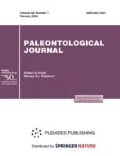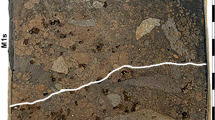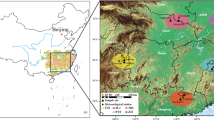Abstract
Proportions of 13C/12C and 15N/14N isotopes were identified in different woody compartments of birch (Betula pendula Roth), pine (Pinus sylvestris L.) and aspen (Populus tremula L.) trunks in preforest-steppe and pine-birch forests of the Middle Urals using mass spectrometry. The data were analyzed and interpreted from the perspective of the biochemical processes of carbon and nitrogen metabolism in leaves, cambial tissue, trunk wood, branches, roots, and soil. A lighter isotopic composition of carbon is characteristic of the leaves and trunk cambium. The trunk wood is characterized by a basal trend for 13C enrichment. The 13C/12C ratio corresponds to the nitrogen content in the trunk wood tissues, indicating metabolic control of carbon fractionation in woody plants. The isotope composition of nitrogen in the trunk cambium was significantly depleted in 15N (δ15N varies from –1.5 to –3.5‰) and δ13C (δ13C varies from –28.3 to –25.8‰). Meanwhile the sapwood (δ15N varies from –2.6 to 1‰ and δ13C varies from –27.5 to –27.1‰) and heartwood (δ15N varies from –2.5 to –3.5‰ and δ13C varies from –26 to –24.5‰) were more enriched in 15N and 13C. The significant difference between the values of 13C and 15N isotope discrimination consequently in the different woody compartments of trunk should be taken into account when interpreting data of wood organic matter in the context of paleoclimate.


Similar content being viewed by others
Notes
Abbreviations: δ13C—an isotope discrimination of the heavy (13C) carbon isotope; δ15N—an isotope discrimination of the heavy (15N) nitrogen isotope.
REFERENCES
Evans, D.R., Physiological mechanisms influencing plant nitrogen isotope composition, Trends Plant Sci., 2001, vol. 16, pp. 121–126.
Galimov, E.M., Geokhimiya stabil’nykh izotopov ugleroda (Geochemistry of Stable Carbon Isotopes), Moscow: Nedra, 1968.
Kosintsev, P., Mitchell, K.J., Devièse T., van der Plicht, J., Kuitems, M., Petrova, E., Tikhonov, A., Higham, T., Comeskey, D., Turney, Ch., Cooper, A., van Kolfschoten, Th., Stuart, A.J., and Lister, A.M., Evolution and extinction of the rhinoceros Elasmotherium sibiricum sheds light on late Quaternary megafaunal extinctions, Nature Ecology & Evolution, 2019, vol. 3, pp. 31—38.
Leavitt, S.W., and Long, A., Stable carbon isotope variability in tree foliage and wood, Ecology, 1986, vol. 67, pp. 1002–1010.
Leavitt, S.W., Tree-ring C–H–O isotope variability and sampling, Sci. Total Environ, 2010, vol. 408, pp. 5244—5253.
Marshall, J.D., Brooks, J.R., and Lajtha, P., Sources of variation in the stable isotopes of plants, Stable Isotopes in Ecology and Environmental Science. 2nd Edition, Mitchener, R., Lajtha, K., Eds., Oxford: Blackwell Scientific, 2007, pp. 22–60.
Martinelli, L.A., Piccolo, M.C., Townsend, A.R., Vitousek, P.M., Cuevas, E., McDowell, W., Robertson, G.P., Santos, O.C., and Treseder, K., Stable nitrogen isotope composition of leaves and soil: Tropical versus temperate forests, Biogeochemistry, 1999, vol. 46, pp. 45–65.
Mukhin, V.A., Tret’yakova, A.S., Teptina, A.Yu., Kutlunina, N.A., Zimnitskaya, S.A., Goncharova, Yu.V., Yudin, M.M., and Berezina, A.Ya., Flora i rastitel’nost’ biologicheskoi stantsii Ural’skogo gosudarstvennogo universiteta: Ucheb. posobie po letnei polevoi praktike dlya studentov biol. fak. (Flora and Vegetation of the Biological Station of Ural Federal University: a Reference Book for the Summer Field Practical Work for Students of the Biological Faculty), Ekaterinburg: Izd. Ural. un-ta, 2003.
Mukhin, V.A., Voronin, P.Yu., Velivetskaya, T.A., Ignat’ev, A.V., and Kuznetsov, Vl.V., Fractionation of stable nitrogen and carbon isotopes during oxidative conversion of organic matter of the woody pool forest ecosystems, Dokl. Biol. Sci., 2013, vol. 453, pp. 369—370.
O’Leary, M.H., Carbon isotope fractionation in plants, Phytochemistry, 1981, vol. 20, pp. 553–567.
Mukhin, V.A., Voronin, P.Yu., Velivetskaya, T.A., and Ignat’ev, A.V., Stable carbon isotope ratio in xylotrophic fungi and their substrates, Russian J. Ecol., 2014, no. 1, pp. 14–21.
Robinson, D., d15N as an integrator of the nitrogen cycle, Trends Ecol. Evol., 2001, vol. 16, pp. 153–162.
Tiunov, A.V., Stable isotopes of carbon and nitrogen in soil ecological studies, Biol. Bull., 2007, no. 34, pp. 395–407.
Voronin, P.Yu., Mukhin, V.A., Velivetskaya, T.A., Ignat’ev, A.V., and Kuznetsov, Vl.V., Isotope composition of carbon and nitrogen in tissues and organs of Betula pendula, Russ. J. Plant Physiology, 2017, vol. 64, pp. 184–189.
Yakir, D., Global enzymes: Sphere of influence, Nature, 2002, vol. 416, pp. 795–795.
Zagirova, S.V., and Kuzin, S.N., Cambial activity and CO2 exchange in Pinus sylvestris trunk, Russ. J. Plant Physiology, 1998, vol. 45, pp. 633–638.
Zavarzin, G.A., Lektsii po prirodovedcheskoi mikrobiologii (Lectures on Microbiology in Natural Sciences), Moscow: Nauka, 2004.
Funding
The study was supported by the Government of the Russian Federation (state assignment no. 211, contract no. 02.A03.21.0006 and АААА-А18-118012690362-7), the Russian Foundation for Basic Research (project no. 15-04-06881), and the Ural Branch of the Russian Academy of Sciences (project no. 15-12-4-27)
Author information
Authors and Affiliations
Corresponding author
Additional information
Translated by T. Foraponova
Rights and permissions
About this article
Cite this article
Voronin, P.Y., Mukhin, V.A., Velivetskaya, T.A. et al. Carbon and Nitrogen Isotope Composition of the Wood of Pinus sylvestris, Betula pendula and Populus tremula . Paleontol. J. 54, 819–824 (2020). https://doi.org/10.1134/S0031030120080171
Received:
Revised:
Accepted:
Published:
Issue Date:
DOI: https://doi.org/10.1134/S0031030120080171




